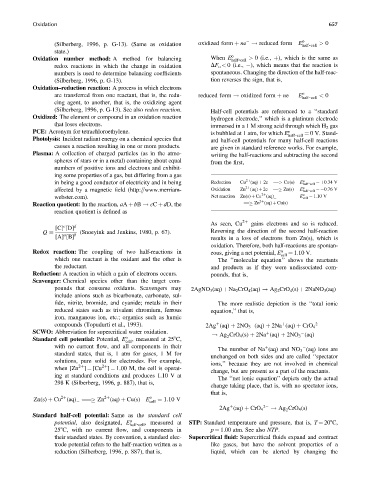Page 702 - Fundamentals of Water Treatment Unit Processes : Physical, Chemical, and Biological
P. 702
Oxidation 657
(Silberberg, 1996, p. G-13). (Same as oxidation oxidized form þ ne ! reduced form E o half-cell > 0
state.)
Oxidation number method: A method for balancing When E o half-cell > 0 (i.e., þ), which is the same as
redox reactions in which the change in oxidation DF o < 0 (i.e., ), which means that the reaction is
numbers is used to determine balancing coefficients spontaneous. Changing the direction of the half-reac-
(Silberberg, 1996, p. G-13). tion reverses the sign, that is,
Oxidation–reduction reaction: A process in which electrons
are transferred from one reactant, that is, the redu- reduced form ! oxidized form þ ne E o < 0
half-cell
cing agent, to another, that is, the oxidizing agent
(Silberberg, 1996, p. G-13). See also redox reaction. Half-cell potentials are referenced to a ‘‘standard
Oxidized: The element or compound in an oxidation reaction hydrogen electrode,’’ which is a platinum electrode
that loses electrons. immersed in a 1 M strong acid through which H 2 gas
PCE: Acronym for tetrachloroethylene. is bubbled at 1 atm, for which E o half-cell ¼ 0 V. Stand-
Photolysis: Incident radiant energy on a chemical species that ard half-cell potentials for many half-cell reactions
causes a reaction resulting in one or more products. are given in standard reference works. For example,
Plasma: A collection of charged particles (as in the atmo- writing the half-reactions and subtracting the second
spheres of stars or in a metal) containing about equal from the first,
numbers of positive ions and electrons and exhibit-
ing some properties of a gas, but differing from a gas
o
in being a good conductor of electricity and in being Reduction Cu (aq) þ 2e ¼¼ Cu(s) E half-cell ¼þ0.34 V
2þ
o
affected by a magnetic field (http:==www.merriam- Oxidation Zn (aq) þ 2e ¼¼ Zn(s) E half-cell ¼ 0.76 V
2þ
o
webster.com). Net reaction Zn(s) þ Cu (aq)_ E cell ¼ 1.10 V
2þ
Reaction quotient: In the reaction, aA þ bB ! cC þ dD, the ¼¼ Zn (aq) þ Cu(s)
2þ
reaction quotient is defined as
As seen, Cu 2þ gains electrons and so is reduced.
c
d
[C] [D]
(Snoeyink and Jenkins, 1980, p: 67): Reversing the direction of the second half-reaction
Q a b
[A] [B] results in a loss of electrons from Zn(s), which is
oxidation. Therefore, both half-reactions are spontan-
Redox reaction: The coupling of two half-reactions in eous, giving a net potential, E o ¼ 1.10 V.
cell
which one reactant is the oxidant and the other is The ‘‘molecular equation’’ shows the reactants
the reductant. and products as if they were undissociated com-
Reduction: A reaction in which a gain of electrons occurs. pounds, that is,
Scavenger: Chemical species other than the target com-
pounds that consume oxidants. Scavengers may 2AgNO 3 (aq) þ Na 2 CrO 4 (aq) ! Ag 2 CrO 4 (s) þ 2NaNO 3 (aq)
include anions such as bicarbonate, carbonate, sul-
fide, nitrite, bromide, and cyanide; metals in their The more realistic depiction is the ‘‘total ionic
reduced states such as trivalent chromium, ferrous equation,’’ that is,
iron, manganous ion, etc.; organics such as humic
compounds (Topudurti et al., 1993). þ þ 2
2Ag (aq) þ 2NO 3 (aq) þ 2Na (aq) þ CrO 4
SCWO: Abbreviation for supercritical water oxidation. ! Ag CrO 4 (s) þ 2Na (aq) þ 2NO 3 (aq)
þ
Standard cell potential: Potential, E o , measured at 258C, 2
cell
with no current flow, and all components in their
The number of Na (aq) and NO 3 (aq) ions are
þ
standard states, that is, 1 atm for gases, 1 M for
unchanged on both sides and are called ‘‘spectator
solutions, pure solid for electrodes. For example,
ions,’’ because they are not involved in chemical
when [Zn ] ¼ [Cu ] ¼ 1.00 M, the cell is operat-
2þ
2þ
change, but are present as a part of the reactants.
ing at standard conditions and produces 1.10 V at
The ‘‘net ionic equation’’ depicts only the actual
298 K (Silberberg, 1996, p. 887), that is,
change taking place, that is, with no spectator ions,
that is,
Zn(s) þ Cu (aq) ¼¼¼ Zn (aq) þ Cu(s) E o ¼ 1:10 V
2þ
2þ
cell
þ 2 ! Ag CrO 4 (s)
2Ag (aq) þ CrO 4
2
Standard half-cell potential: Same as the standard cell
potential, also designated, E o , measured at STP: Standard temperature and pressure, that is, T ¼ 208C,
half-cell
258C, with no current flow, and components in p ¼ 1.00 atm. See also NTP.
their standard states. By convention, a standard elec- Supercritical fluid: Supercritical fluids expand and contract
trode potential refers to the half-reaction written as a like gases, but have the solvent properties of a
reduction (Silberberg, 1996, p. 887), that is, liquid, which can be alerted by changing the

